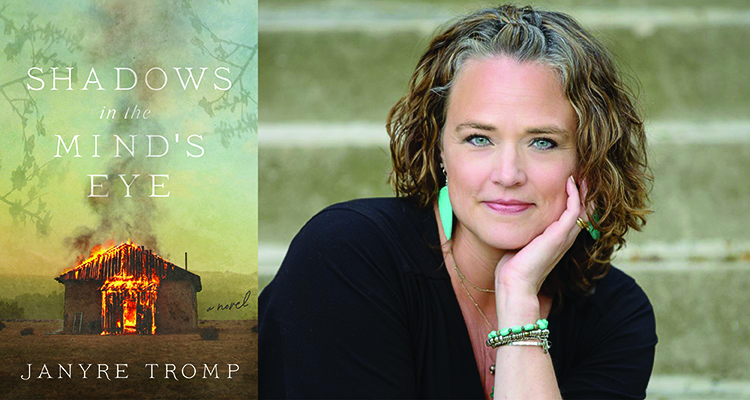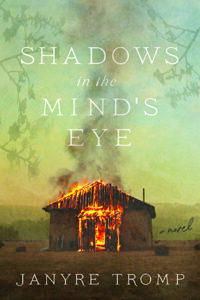Janyre Tromp (pronounced Jan-ear) is a historical suspense novelist who loves spinning tales that, at their core, hunt for beauty, even when it isn’t pretty. She’s the author of Shadows in the Mind’s Eye and coauthor of It’s a Wonderful Christmas. A firm believer in the power of an entertaining story, Tromp is also a book editor and published children’s book author.
Janyre’s inspiration for her debut novel, Shadows in the Mind’s Eye, was her own grandparents’ stories of adjusting to life when her grandfather returned home from World War II. Back then, soldiers returning home rarely talked about their experiences and the difficult adjustment of “getting back to normal.” In the process of writing the story, the author did extensive research on treatments for what was known as battle fatigue at the time. She also drew on personal experiences in dealing with PTSD herself.
Let’s see what else she can tell us about Shadows in the Mind’s Eye.
FF: In our current day, we are very aware of what PTSD is, and that it is very prevalent among men and women who have been in the military and seen war. What was known about PTSD back in the 1940s after World War II?
Although the general population didn’t shame WWII soldiers with PTSD symptoms as much as they did their WWI counterparts, WWII era doctors knew little about how to treat trauma of any kind. Battle fatigue, as it was known then, was treated with electroshock therapy (something that was terrifying and had limited success), and many of the men who suffered from it were often divorced, angry, confused, and quietly addicted to drugs and alcohol. Of course, I didn’t want to leave Sam and Annie here, so I dug for treatment options and talked with a few modern therapists.
In my research, those who fared best were often those who lived a little off the grid, in places where they could be physically active, with people who loved them and gave them the space to remove themselves when necessary. Sam also stumbles on a bit of a modern treatment technique by accident. Most folks have heard that going for a walk can help with mental stability. What isn’t as familiar is that the rhythm of walking combined with talking can actually replicate bits and pieces of EMDR (Eye Movement Desensitization and Reprocessing) therapy which is one of the most successful battlefield PTSD treatments.
FF: What kind of research did you do on the effects of war during that time period? What sparked the inspiration for that part of the story?
As I mentioned, the initial interest came from my grandparents and their stories. But PTSD is also something I’ve struggled with for years. I had some childhood trauma that I worked through back in college. I started writing this book using the nightmares and struggles I had as a kid. Then my daughter became very, very ill which sparked a new trauma all its own.
That said, battlefield PTSD has different components than the trauma I suffered. To research that, I had several long conversations with a friend who treats battlefield PTSD. She’s the one who reminded me that EMDR is, in essence, any activity that uses bilateral stimulation to trigger both sides of the brain—thus the positive effects of walking and wide-open spaces. I also read Soldiers from the War Returning by Thomas Childers to get an idea of the authentic story of the men returning from war; The Body Keeps the Score by Bessel van der Kolk, M.D. for how PTSD affects the brain and body; and Wounded Warrior, Wounded Home by Marshele Carter Waddell and Kelly K. Orr, PhD, ABPP to understand the battlefield specific emotional wounds, and how that affects a warrior’s family.
FF: An author often writes part of herself into the story, or at least something she knows about. How have you been affected by PTSD?
There have been long stretches of my life where I was all too familiar with debilitating fear. I still have occasional flashes from my childhood, the rush of adrenaline causing my pulse to pound and hands to shake. I was terrified to have kids, to be the one responsible for their physical/mental/emotional wellbeing. The last thing I wanted was for them to have the same problems I had. But, as Dovie May says, “The best place for miracles is where we don’t fully believe, where our believing has run out.” My husband, Chris, and his family, as well as my good friend, Sarah De Mey, and my mom (who worked hard to get help), have been amazing role models for me as I navigate what it looks like to raise emotionally healthy kids.
All that peace came crashing down when my daughter became ill. She was hospitalized seven times over a few months’ time and the doctors had no idea what caused her illness. After months of visiting doctors to find out why my thirteen-year-old daughter was experiencing increasing abdominal pain, she collapsed at school. What followed was a living nightmare. Doctors found her abdominal cavity full of a fungal infection that quickly went septic. That was the first time we almost lost her. Months later, she’d lost more than forty pounds, and both she and I were wracked with nightmares, an inability to drive anywhere near the hospital, or be in a room with needles. To this day, I can’t smell rubbing alcohol without my body responding with panic.
On paper she should not have survived, and I can’t describe the immense fear that comes from the Pediatric ICU or a parade of doctors. My girl is doing great now, but I don’t think it’s a coincidence that I didn’t finish the book, and hadn’t found the path to hope until after my daughter had walked out of the hospital for the last time.
I’m enormously grateful for EMDR, my therapist, and the grace of God that much of my fear is gone.
FF: You’ve been on the publisher’s side of things for many years, both in marketing and as an editor working with authors. Have you always wanted to write as well? Has anything surprised you being on the author side?
I didn’t start writing or really even think about being a writer until a few years into my career as the marketing manager for a publisher. I actually started college as a chemistry major and ended up as an English major by default. There’s a whole story in here about me being a sassy know-it-all seventeen-year-old punk, and my mom being right. But suffice it to say, the major change was me heeding my mom’s advice to do what I loved (reading).
Anyway, I was freelancing for our editorial department, and our managing editor asked me if I would consider writing a book. It sounded interesting. I wrote a short novel for the middle schoolers I mentored at my church, then I did a few picture books for my daughter, and then I took a long break to raise my kids. When I found time to write a book again, it was so life-giving, I don’t even have words to describe it. I was hooked.
But let me tell you that being an author has changed drastically in the last decade. There’s a much heavier load to lift for authors now—both in terms of tracking story trends and marketing. But it’s also easier than ever to be in contact with readers. I absolutely adore the opportunity to chat with folks about their lives on Facebook, see their pictures on Instagram, and just talk books with the world. It’s crazy to me that I can chat with friends in California and Australia and South Africa and Brazil just by typing (or speaking) into a little box on a screen. I will forever love technology for that.
The writing community also took me by surprise. I don’t think I’ve ever been in a varied group as welcoming and helpful as this group. They’ve been a tremendous support as I’ve worked through edits and marketing and all the highs and lows that come with publishing. There’s so much love and joy there. Julie Cantrell, Rachel McDaniel, Janine Rosche, Susie Finkbeiner, J’nell Ciesielski, and so many more have been absolutely amazing.
Shadows in the Mind’s Eye
Janyre Tromp
Kregel Publications
Genres: Historical, Historical Romance
Release Date: April 19, 2022
ISBN-10: 0825447399
ISBN-13: 978-0825447396
Book Summary:
Charlotte Anne Mattas longs to turn back the clock. Before her husband, Sam, went to serve his country in the war, he was the man everyone could rely on—responsible, intelligent, and loving. But the person who’s come back to their family farm is very different from the protector Annie remembers. Sam’s experience in the Pacific theater has left him broken in ways no one can understand—but that everyone is learning to fear.
Tongues start wagging after Sam nearly kills his own brother. Now when he claims to have seen men on the mountain when no one else has seen them, Annie isn’t the only one questioning his sanity and her safety. If there were criminals haunting the hills, there should be evidence beyond his claims. Is he really seeing what he says, or is his war-tortured mind conjuring ghosts?
Annie desperately wants to believe her husband. But between his irrational choices and his nightmares leaking into the daytime, she’s terrified he’s going mad. Can she trust God to heal Sam’s mental wounds—or will sticking by him mean keeping her marriage at the cost of her own life?
Buy Shadows in the Mind’s Eye from the FF Store HERE!
Buy Shadows in the Mind’s Eye from Amazon HERE!



